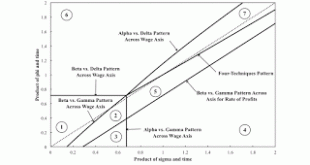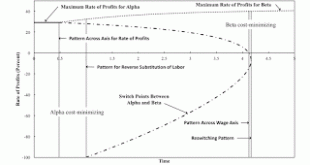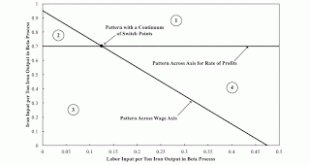Figure 1: Partition of the Parameter Space1.0 Introduction I here provide some notes on a perturbation of an example from Salvadori and Steedman (1988). Consider an economy in which n commodities are produced in n industries. In each industry, a single commodity is produced from inputs of labor and the services of previously produced capital goods. Suppose the technology can be represented in each industry by a continuously-differentiable production function. The wage-rate of profits...
Read More »From Odo’s Prison Letters
For we each of us deserve everything, every luxury that was ever piled in the tombs of the dead kings, and we each of us deserve nothing, not a mouthful of bread in hunger. Have we not eaten while another starved? Will you punish us for that? Will you reward us for the virtue of starving while others ate? No man earns punishment, no man earns reward. Free your mind of the idea of deserving, the idea of earning, and you will begin to be able to think. -- Ursula K. Le Guin (21 October 1929 -...
Read More »Labor Values Taken As Given
I have been considering a case in which a simple Labor Theory of Value (LTV) is a valid theory of prices of production. When, for each technique, all processes have the same organic composition of capital, prices of production are proportional to labor values. Given labor values and direct labor coefficients in each industry, an uncountably infinite number of techniques - as specified by a Leontief input-output specified in terms of physical inputs per physical outputs - satisfies these...
Read More »Start of a Catalogue of Flukes of Fluke Switch Points
I claim that the pattern analysis I have defined can be used to generate additional fluke switch points. I am particularly interested in switch points that are flukes in more than one way (local patterns of co-dimension higher than one) and fluke switch points that are combined with other fluke switch points or some aspect of other switch points (global patterns). I have already generated some examples, not always with pattern analysis. Fluke switch points of higher co-dimension A switch...
Read More »A Pattern For The Reverse Substitution Of Labor
Figure 1: Variation of Switch Points with Time1.0 Introduction This post presents another local pattern of co-dimension one. I have conjectured that only four types of local patterns of co-dimension one exist (a reswitching pattern, a three-technique pattern, a pattern across the wage axis, and a pattern over the axis for the rate of profits). In this conjecture, I meant to implicitly limit the rate of profits at which switch points occur to be non-negative and not exceeding the maximum...
Read More »Labor Values As A Foundation
Figure 1: Physical Production Data as a Side Route1.0 Introduction One way of reading the first volume of Marx's Capital is that labor values provide a foundation, upon which the structure of prices of production and, eventually market prices are based. I find that, for example, Joseph Schumpeter presents Marx's work in this way. Another reading takes both labor values and prices as founded on physical data specifying the technique in use. Ian Steedman, as illustrated in Figure 2,...
Read More »Perturbation Of An Example With A Continuum Of Switch Points
Figure 1: A Partitioning Of The Parameter Space1.0 Introduction I consider here a case where two different techniques have the same wage curve. A simple labor of theory of value describes prices in the case under consideration. I treat the labor coefficient and another coefficient of production for a process in one technique as parameters. And I look at what happens when they vary. A note on terminology: on the basis of expert advice and peer review, I am no longer using the term...
Read More »Elsewhere
Steve Keen and others, in a showy bit of performance art in London, have called for a reformation of economics. Imitating Luther, they have nailed some theses to a door. Here's some links: Guardian article Letters to the editor in response. New Weather Institute blog post. 33 Theses. An article by Ben Chu, in the Independent saying, more or less, let's not get carried away. I do not know who Charles Mudede is or what his platform is. His style is more popular and very different from mine....
Read More »2017 Presentation on Ireland
My 2017 presentation on Ireland and the Eurozone has been uploaded to YouTube. See the previous post for the link to the full conference, which includes the Q&A. [embedded content] Advertisements
Read More »Richard Thaler Confused On Microeconomics
Richard Thaler espouses an incorrect imperfectionist viewpoint. If only all markets were competitive, agents did not suffer from limitations in calculating and lack of information, etc., all markets would clear. Or so he says, at least when it comes to the labor market: Perceptions of fairness ... help explain a long-standing puzzle in economics: in recessions, why don't wages fall enough to keep everyone employed? In a land of Econs, when the economy goes into a recession and firms face...
Read More » Heterodox
Heterodox




